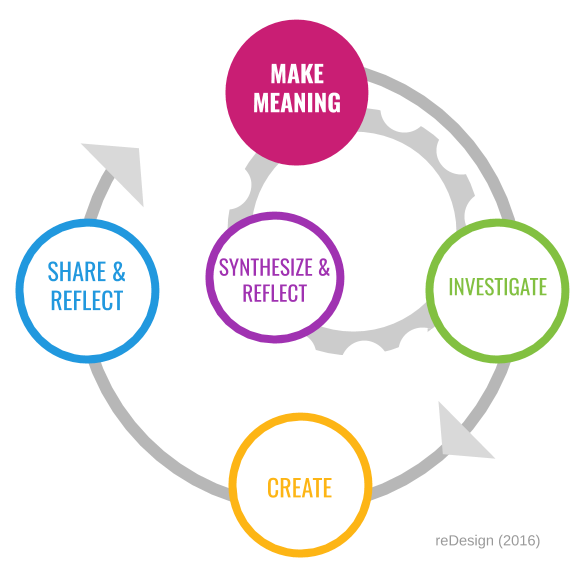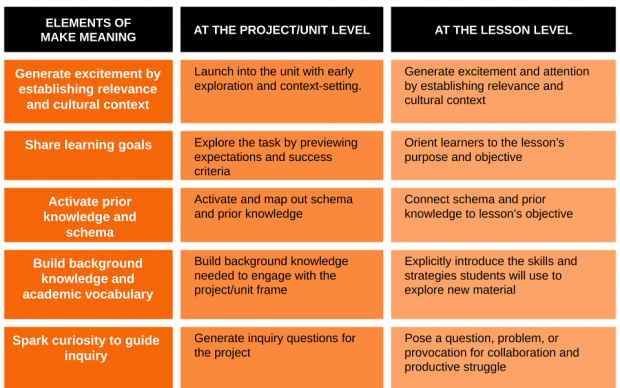
by Jon M Altbergs & Laurie Gagnon
At reDesign, we encourage the adoption of a Learning Cycle that guides the learner through the habits and skills that support the development of competency with practice over time.
In our last blog post, we wrote about the importance of synthesis and reflection questions to complete the learning loop. In this post, our second of five posts about the Learning Cycle, we’re going to explore the Make Meaning stage of the Learning Cycle. As you may recall from our last post, the “inner circle” refers to the structure of the daily learning experiences that make up the unit of study or project, which is represented by the “outer circle.” Make meaning happens in both the inner and outer arcs of the learning process.

In the Make Meaning stage of the learning cycle, students activate prior knowledge and build new background knowledge in preparation for investigating an overarching question or problem frame. Remembering and comprehending—the lowest levels of Bloom’s Taxonomy—is the work of the Make Meaning phase. However, without this critical step students with gaps in background knowledge, academic vocabulary, or other building blocks of understanding will likely struggle to deeply engage with essential content and skills.

Making Meaning to launch learning experiences ensures that students are well prepared for the work. Let’s address a common misconception, though: students shouldn’t be asked to “learn” a bunch of out-of-context content before diving into the investigation. In fact, the Make Meaning phase should be the shortest phase of the learning cycle at both the unit level and the daily lesson level. You may recognize intuitively that traditional learning experiences often focus on transferring the content from teacher to student, with very little time for students to apply skills to content. Instead, our learning cycle-based approach promotes “just in time learning,” with students getting what they need when they need it.
If we leave the classroom for the soccer field, we can see this in action: No coach would expect their players to learn all the rules of the game before breaking out the soccer balls. To get students “out on the field” quickly, we want to keep the Make Meaning part of a project or lesson to a minimum and address questions as they emerge. At the start of a unit, this means two or three lessons before beginning the Investigation phase and at the beginning of a lesson, no more than 20% of time is spent on direct instruction and modeling.
Whether launching into a longer term project or the learning of the day, learners need to start with their own schema and have a reason to learn. Research on learning helps us understand what is going on in the brain when we learn. Piaget described learning as the process of building, adapting, and expanding one’s schema—the way we organize knowledge in the brain. If you don’t know what you already know, it’s hard to build your knowledge and skills or accommodate new ideas. Engagement is equally important. Providing multiple means of engagement activates the “Why” of learning in the Universal Design for Learning framework with the ultimate goal of cultivating expert learners who are purposeful and motivated. Culturally Responsive Teaching theory and practice further guides practitioners in thinking about what is engaging to our full range of learners. CRT pushes us to identify specific strategies that engage diverse students, through “using the cultural knowledge, prior experiences, frames of reference, and performance styles of ethnically diverse students to make learning encounters more relevant to and effective for them (p. 31).” Broadly speaking, making meaning helps us apply research and theory to the interconnected goals of connectedness and competency.
Sharing our schema—what we think and know, and what we don’t yet know—requires trust. And building trust is also a prerequisite for engagement in the learning process. When the learning environment fosters connectedness, we are primed to trust and engage. Learner connectedness blossoms from our relationships with our learners and the space we create for every learner to bring their whole self into the learning process. Welcoming learner identities and encouraging connection and curiosity through make meaning activities leads to engagement in a safe and welcoming learning community.
Because the learner taps into their existing knowledge, transparency about the target competencies enhances the efficacy of learning activities. Developing competency means that learners know what they are learning and how they can apply that learning. Increased autonomy through goal setting, planning, and inquiry supports learners in developing self-awareness of the learning goals and their strategies for achieving those goals. The making meaning process supports the teacher and learner in identifying where students are so that we can meet them where they are in their learning and scaffold appropriately.
OK, I’m sold on including opportunities for Making Meaning. Where do I start?
We offer these practical ways to engage learners in making meaning and we can only imagine the ideas you can add with your knowledge of your specific learners. The goal isn’t to do every one of these, but rather to use them to get started. Most of these ideas can work in person, in synchronous virtual settings, or as asynchronous learning activities. While we might lament that we can’t take a physical field trip or host a guest speaker, perhaps a virtual field trip or guest allows exposure to people and places that would be out of reach due to geography or budget. Whatever your current context and teaching configuration, we hope that creating opportunities for making meaning supports you and your learners in making the most of your learning time.
Make Meaning Elements |
Make Meaning Activity Ideas |
| Generate excitement |
|
| Share learning goals |
|
| Activate prior knowledge |
|
| Build background knowledge and academic vocabulary |
|
| Spark curiosity |
|
If you’re interested in hands-on learning and support to help you design learning experiences that are research-based and built around the learning cycle, check out the workshop series, The Learning Cycle Workshop, offered through reDesign’s Institute. We hope to see you there!
